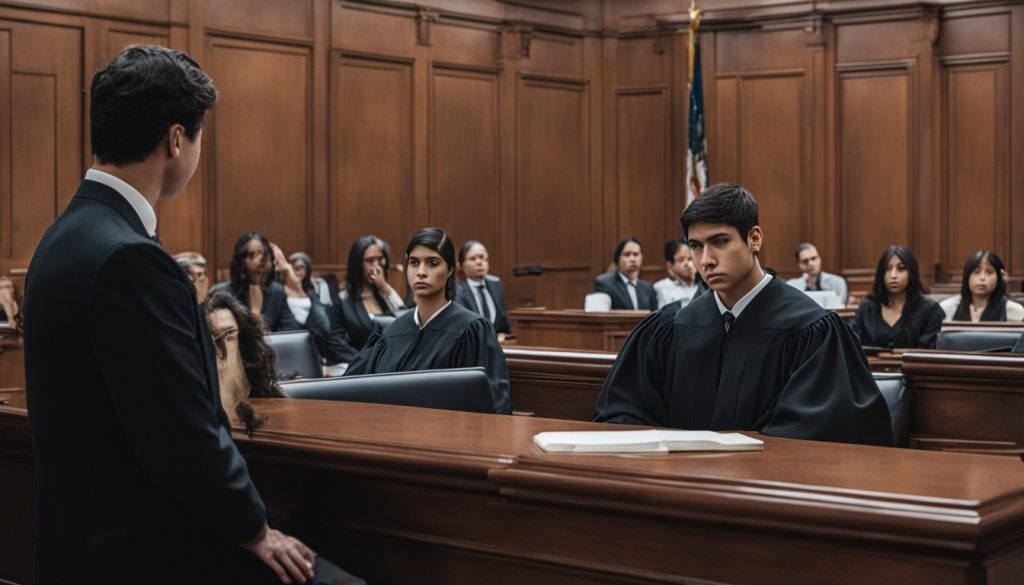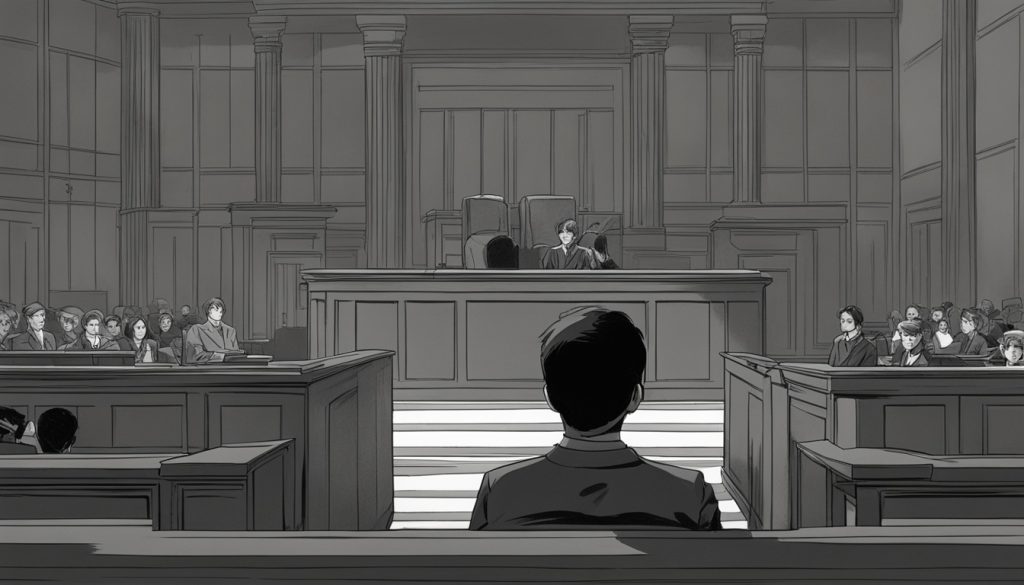When a minor, or “juvenile,” under 18 breaks the law, they face a system different from adults. This system is called the juvenile justice system. It aims to help young people with the right kind of help, support, and accountability1.
After a juvenile gets arrested, an officer will check the situation. They decide if the youth can go home or if they need to stay in a detention center1. Juveniles can be charged with many crimes, like hitting someone, stealing, breaking into a store, or driving under the influence1.
Key Takeaways
- Juveniles under 18 are treated differently than adults in the justice system.
- The focus is on helping them learn from their mistakes rather than just punishing them.
- They can be charged with anything from small crimes to serious violent acts.
- Officers decide if a juvenile should be detained or sent home.
- The system tries to help young people get back on track with the right support.
Understanding Juvenile Justice
What Constitutes a Juvenile?
The juvenile justice system is a special legal setup for young people accused of breaking the law. To be in juvenile court, a person must be seen as a “juvenile” by state laws2. Most states say the top age for juvenile court is 18, with a few exceptions. This court is part of the Superior Court, made for cases about underage offenders and juvenile delinquency3.
This system believes young people need a different way of handling their cases because they are still growing. It focuses on helping them, using community programs, and looking at their situation, not just punishing them2. The main aim is to help young people learn from their mistakes and become good citizens4.
| Characteristic | Juvenile Justice System | Adult Criminal Justice System |
|---|---|---|
| Purpose | Rehabilitation and Guidance | Punishment and Deterrence |
| Jurisdiction | Usually up to age 18 (with some exceptions) | Age 18 and above |
| Proceedings | Informal, focused on the individual’s circumstances | Formal, focused on the offense |
| Sentencing | Emphasizes community-based interventions and services | Typically includes incarceration and fines |
The juvenile justice system is a special way to help young people who have gotten into trouble with the law. It’s important to know what makes someone a “juvenile” and how this system works. This helps us see how it tries to fix juvenile delinquency and help underage offenders get back on track243.
Common Juvenile Offenses
In the U.S., helping young people who commit minor crimes is a key goal to keep them out of adult prisons5. Places like juvenile detention centers offer counseling, rehab programs, and school for these young people5. Programs like the Juvenile Detention Alternatives Initiative (JDAI) help reduce the number of kids in detention and stop them from committing more crimes5.
Common crimes among young people include vandalism, stealing small items, drinking or using drugs before they’re allowed to, fighting, sexual crimes, hitting someone in their family, and breaking rules like skipping school or being out too late56.
Vandalism means doing things like writing graffiti, scratching cars, or breaking windows5. Taking something worth less than $500 is another common crime that might lead to paying back what you took, doing community service, or helping out in some other way5. Drinking or using drugs before you’re supposed to can lead to counseling, fines, or more serious consequences5.
Simple fights can lead to assault charges, and if they’re really bad, they might be tried in adult court5. Young people might also be charged with sexual crimes like making child pornography or having sex with someone who is too young5. Violence against family members can lead to serious punishments, even being sent to an adult prison, or being taken away from home5.
Some crimes, like breaking rules about being out late or skipping school, are special crimes for young people5. Every year, about 400,000 young people get arrested, charged, or put in detention for these kinds of crimes6. About 20% of the time, crimes that would get an adult in trouble don’t get the same attention just because of the person’s age6.
https://www.youtube.com/watch?v=LY0Zs47BJ9I
More and more young people are getting arrested and charged with crimes lately7. They can be charged with violent crimes, stealing, drug crimes, or breaking rules7. Most places don’t hold kids under seven responsible for crimes because they think they’re too young to know right from wrong7.
When they turn 18, most criminal records from when they were young get sealed, so they can start fresh7. The federal government helps states and local areas with money for programs to stop crime, help find missing kids, and help runaways and homeless youth7.
Instead of jail, young people might do things like pay back what they took, go to school or therapy, follow a curfew, or be on probation7. The goal is to help them change their ways, not just punish them. This is different from how adults are treated in the justice system7.
If a crime is really serious, a prosecutor might decide to try a young person as an adult7. This depends on the crime, the young person’s age, and their past actions7.
juvenile justice, minor crimes, juvenile court, youth offenders
The juvenile justice system in the U.S. is made to help minors who break the law. It’s different from the adult system, focusing on helping young people instead of just punishing them. The goal is to make sure young offenders don’t commit crimes again and grow up to be law-abiding citizens8.
When a minor commits a crime, they’re seen as a “juvenile delinquent.” Their case goes to a special court, not an adult court9. This court aims to help young people learn from their mistakes and stay safe in their communities8.
Young people can commit a range of crimes, from small ones like underage drinking to serious ones like assault9. The system knows young people can make errors. It gives them a chance to learn and change8.
In Florida, the Department of Juvenile Justice has programs to prevent and address delinquency8. These programs help young people develop skills and support to be productive citizens. The National Interstate Commission for Juveniles also helps manage the transfer of juvenile supervision between states8.
Even though the focus is on helping young people, keeping the community safe is also key. Sometimes, a juvenile might be tried as an adult for a serious crime9.
The juvenile justice system is a vital part of helping young people. It offers a caring and effective way to deal with minor crimes and support young offenders8109.
Juvenile Court Process
When a minor is accused of a crime, they might not go to regular court. Instead, they could join a “youth diversion program”11. This is for first-time offenders or for less serious crimes11. The main goal is to help the minor and their guardian make a plan. This plan might include paying back what was lost, staying in by a certain time, paying fines, taking classes, getting counseling, or doing community service11.
If the case goes to court, there will be a “fact-finding hearing”11. This is like a mini-trial. In 2021, about 437,000 young people were sent to juvenile courts for crimes. Another 51,500 were sent for other issues12. Of these crimes, 56% went through a full court process. About 118,000 youth were officially found guilty12.
Diversion Programs
Diversion programs are an alternative to going to court11. They focus on helping young people deal with their issues and get back on track11. If a youth finishes a diversion program, they might not have a criminal record11.
In 2021, many young people were put on probation or taken out of their homes and put in facilities12. On October 27, 2021, almost 25,000 youth were in facilities, including 11,000 waiting for trial and over 13,000 in long-term facilities12.
How states handle diversion and rehab programs can be very different13. Laws and rules change a lot from state to state13.
Learning about the juvenile court process and diversion programs helps us help young offenders better111213. This can lead to less crime and better rehabilitation111213.
Trying Juveniles as Adults
In some cases, young offenders can face trial in adult criminal court. The decision to move a case from juvenile to adult court depends on the crime’s seriousness and the youth’s criminal history14. If the crime is serious and the youth is 16 or older, they will face trial in Superior Court as an adult14.
In Florida, the decision to charge a minor as an adult is up to the prosecutor14. A 14-year-old can be tried as an adult for certain serious crimes14. Crimes like arson and murder can lead to a trial in adult court for minors14. If a minor is 16 or older, they can be tried as an adult for any felony14.
For minors committing misdemeanors, being tried as an adult is possible if they have a history of juvenile crimes14. In Florida, prosecutors can send a minor’s case to adult court without a judge’s approval15. Even at 14 or 15, a minor can face adult court for serious crimes like sexual battery15. Minors aged 16 to 17 may automatically go to adult court for any felony15.
Being tried as an adult can have serious effects on a minor, including a permanent criminal record14. This can affect their future in education, employment, and even their rights15. Unlike juvenile records, adult convictions in Florida are not easily erased15.
The juvenile court system often lacks the attention needed, leading to some youths reoffending16. Some believe that knowing they can’t be tried as adults leads to crime16. Victims’ families feel the current system is too lenient, highlighting the need for understanding that young people can commit serious crimes16.
Legal Representation
When a minor is charged with a juvenile crime, getting a skilled juvenile defense lawyer is key. Juvenile records can affect their future in big ways, like their school chances, job prospects, and personal life17.
Juvenile cases have their own rules and steps, different from adult courts. Lawyers who know juvenile law help young people navigate this complex legal world17. They offer support and work for solutions that help fix the issues that led to the crime17.
Getting convicted in juvenile court can really impact a youth’s future17. Lawyers try to lessen these effects by negotiating for better sentences. They look for options like programs or probation that focus on helping the youth, not just punishing them17.
It’s very important for juveniles to have a good lawyer17. Juvenile defense lawyers are key in making sure young people’s rights are respected. They help ensure fair trials and protect their future in the juvenile justice system17.
| Juvenile Crime Trends | Juvenile Court Outcomes | Juvenile Residential Placement |
|---|---|---|
The juvenile justice system aims to help young offenders change for the better. Legal help is key to making sure this happens17. By pushing for options other than jail and tackling the issues behind the crime, juvenile defense lawyers can help young people move forward positively17.

Juvenile Corrections
The juvenile justice system focuses on rehabilitating and reintegrating young people instead of just punishing them. It uses two main methods: probation and residential placement20.
Probation and Residential Placement
Over 90% of young people who get in trouble are put on probation or sent to live in a facility20. On probation, they stay at home but have a probation officer watching over them. They must follow rules, go to treatment, do community service, and pay back what they owe.
About 28% of young people, or around 33,000, were taken out of their homes and put in places like group homes or shelters in 202120. These places can be strict or more like regular homes, depending on what the youth needs.
The system tries to match the right treatment to each young person. It offers everything from staying at home to living in a facility, based on what each one needs18.
Recently, the way we handle juvenile justice has changed a lot. Now, we focus on using what we know works best and helping young people turn their lives around18. We aim to fix the problems that lead to crime, like mental health issues and drug use, to stop them from committing crimes again.
The main goal is to support young people in changing their ways and making their communities safer. We want to help them become good citizens201821.
Conclusion
The juvenile justice system in the U.S. is complex and focused on helping young people who break the law22. It seeks to make them accountable, help them change for the better, and keep communities safe23. The process includes steps like referral, intake, detention, and corrections, aiming to turn young offenders into law-abiding adults22.
Restorative justice is key in this system, focusing on fixing harm and involving the community24. It brings together family, community, and experts to talk about how to make things right and prevent future crimes24. Everyone involved must agree and take part for it to work well24.
The juvenile justice system keeps evolving, aiming to meet the needs of young people, victims, and communities23. It uses programs, legal help, and specific corrections to tackle the causes of crime and help young people change22. By following the youth justice system’s principles, we can build a fairer and more just society for everyone.
FAQ
What constitutes a “juvenile” under the law?
A “juvenile” is a minor under 18. The system helps young people who break the law. It aims to guide them towards better choices.
What are some common juvenile criminal offenses?
Common crimes include assault, shoplifting, and theft. Other offenses are burglary, vandalism, and minor DUI. Possession of drugs, car theft, and sexual assault are also common.
What is the purpose of the juvenile justice system?
The system focuses on accountability and rehabilitation. It aims to help young people avoid future crimes. The goal is to turn them into responsible adults.
What is a “youth diversion program”?
It’s an option for first-time offenders or minor crimes. The program offers alternatives to court. These can include community service or counseling.
Can a juvenile be tried as an adult?
Yes, in some cases, a juvenile can face adult court. This happens if the crime is serious or the juvenile has a history of offenses.
Why is it important for a minor charged with a crime to have legal representation?
Having a lawyer is crucial because a crime can affect a young person’s future. It impacts jobs, college, and more. Experienced lawyers help navigate these issues.
What are the typical outcomes for juvenile offenders?
Most youth get community supervision or residential placement. Those on probation follow rules and may do community service. About one-third are placed in homes away from theirs.
Source Links
- JUVENILE COURT: WHAT HAPPENS WHEN A MINOR BREAKS THE LAW? – Dellino Family Law Group | Experienced Seattle Attorneys | Call 24/7 | Dellino Family Law Group
- Age Boundaries of the Juvenile Justice System | Office of Juvenile Justice and Delinquency Prevention
- Juvenile justice | Definition, Systems, History, & Debate
- Juvenile delinquency, welfare, justice and therapeutic interventions: a global perspective
- 8 of the Most Common Juvenile Offenses – CJB Law
- Juvenile Offenses | Child Crime Prevention & Safety CenterChild Crime Prevention & Safety Center
- Juvenile Crimes & the Legal System
- Florida Department of Juvenile Justice
- Juvenile Crimes
- Children’s Rights in the Juvenile Justice System
- Juvenile justice court process | California Courts
- What Is Juvenile Justice?
- Juvenile Justice System Structure & Process | Office of Juvenile Justice and Delinquency Prevention
- Can Minors Face the Death Penalty in Florida?
- When can a minor be tried as an adult?
- Download
- Youth in Crisis: The Vital Role of Legal Representation in Juvenile Cases
- Youth Involved with the Juvenile Justice System
- Juvenile Court: An Overview
- The Juvenile Justice System | Juvenile Crime, Juvenile Justice
- Youth in the Adult Criminal Justice System | Office of Juvenile Justice and Delinquency Prevention
- Juvenile Delinquency | North Carolina Judicial Branch
- Juvenile justice
- Young People and Restorative Justice

